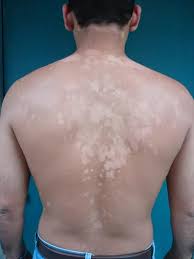Skin Fungus Infection
Skin fungus infection is a very common disease we encounter, we may even experience. A mild skin fungal infection commonly causes skin rash. The rash is harmless, but can be itchy and disturbing appearance.
Mushrooms are primitive organisms that live around our environment, such as air, soil, and even water. Some types of fungi can live in the bodies of animals and humans. Most of the fungi multiply with spores that can be scattered in the air. That is why, fungal infections most often attack the outside of our body, such as the skin and also nails.
People who are actively moving and sweating are more often exposed to skin fungal infections, especially if not careful in maintaining personal hygiene. Diabetics are also susceptible to skin fungal infections. In addition, skin fungus infections are also common in infants and toddlers who use diapers. But in general, anyone can have skin fungal infections.
Types and Symptoms of Skin Fungus Infection Need to Know
Here are the most common types of skin fungal infections:
Dermatophytosis (ringworm). The rash on the skin is reddish and itchy. The red color on the edge is clearer, it looks like a ring, and is firmly bound. Ringworm can be contagious, but it usually does not get worse. May be on the scalp, face, neck, or in other body parts.
Tinea pedis or athlete's foot. Symptoms of skin peeling and cracked in the legs, there are blistered skin and red, itchy and sore. Fungal infections are commonly found on the feet of athletes who are often wrapped in socks and damp. Generally arise on the sidelines of the toes.
Tinea cruris (jock itch). Tinea cruris appears in areas of tender and warm skin folds, for example the buttocks, groin, and genitals. The infected skin will appear reddish and itchy or sore. It often occurs in adolescents and adolescents, or people who often wear tight pants.
Skin candidiasis. The infection is caused by the candida fungus, and can appear anywhere on the body, but it is usually easier to appear in warm, moist areas, such as the groin and the armpit. The infected skin looks red and itchy.
How to Overcome Skin Fungal Infection with Anti-Fungal Drugs
The main treatment of skin fungal infections is with antifungal drugs, especially topical antifungals (oles), such as creams or ointments. Anti-fungal drugs work by destroying the cell wall of the fungus so that the contents of the cell out and the mushroom cells die, or by inhibiting the fungal cells to grow and multiply.
Some types of antifungal drugs commonly used to treat fungal skin infections:
Topical antifungals (oles) - applied directly to skin, hair, or nails.
Oral antifungals - in capsule, pill, or liquid form. Given if skin fungus infection is extensive and can not be overcome with topical antifungal drugs.
There are a variety of topical antifungal drugs with different shapes, brands and strength levels. But in general, antifungal drugs contain clotrimazole, miconazole, nystatin, ketoconazole, or a combination of some of these ingredients. In the drug packaging can be seen the type of drug content in it and how much the composition of the material in the drug, usually written in the form percent (%). Make sure the drug content is strong enough but also not harmful.
Use the medicine as recommended, do not exceed or less than the required amount of use. The drug should remain in use for several days after the rash on the skin is gone, utuk kill the remnants of the fungus that is still left behind.
Topical antifungal drugs are sold freely in pharmacies and shops, and can be purchased without prescription. If after the use of topical medication for 1 to 2 weeks there is no improvement, immediately consult a doctor for further treatment. Do not forget to tell your doctor about any other medications you are taking, to avoid possible side effects due to drug interactions.
How To Avoid Skin Fungus Disease
Maintaining skin hygiene is the key to prevention of skin fungus infections, especially for those who are actively moving, enjoy exercising, or often perform outdoor activities. Here are the things you can do to avoid a yeast infection:
Keep skin clean. Use soap in the bath.
Immediately dry the skin when wet or sweaty.
Change your underwear and socks every day.
Dry the shoe in the open air and keep the inside of the shoe not damp.
Do not exchange towels, underwear and clothes with others.
Use clothes that easily absorb sweat during exercise.
Avoid using pants that are too tight.